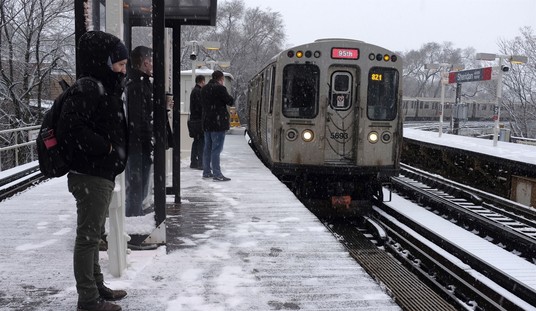Two different home invasions turned out poorly for the criminals in San Antonio (TX) last night:
Residents managed to turn the tide against home invaders during two separate incidents overnight on the West Side.
San Antonio Police Department Sgt. Thomas Brittain said the first home invasion occurred late Tuesday just before midnight in the 100 block of Farrel Drive when a resident heard banging on windows before his front door was broken don.
“(The suspect) broke a window in the back, and then came in through the front door,” Brittain said. “Pretty much bust through the front door … with a bar.”
Once the suspect was in the living room, he was met by the homeowner with a .22 caliber rifle, Brittain said.
The homeowner fired several shots hitting the suspect twice before he fled down the street, police said.
Neighbors began calling police. When they arrived they found the suspect with two gunshot wounds to the chest and an injury to the arm.
The suspect, who police said was in his 30s, was taken to University Hospital and was listed in stable condition with non-life-threatening injuries, police said.
About an hour later, police responded to a call for a home invasion in the 800 block of Brownleaf Drive.
SAPD Sgt. Lena Smith said two men armed with handguns, one with two firearms, began knocking on the door of the house at about 1 a.m.
“Before they could open the door, the door was kicked in by two suspects,” Smith said.
A struggle ensued between the suspects and the homeowner, who managed to take away one of the guns from the suspects, investigators said.
That’s when bullets were exchanged between them, police said.
One suspect was critically injured by the homeowner and transported to University Hospital when responders arrived, Smith said.
“The homeowner was defending himself, of course,” Smith said.
He and the second suspect were shot as well, but both of them were in stable condition when transported to University Hospital.

What can we take away from these incidents? I can think of three things off the top of my head.
- .22LRs are lousy at forcing a fight to stop, even when fired accurately from a rifle.
- Psychological stops are an important.
- It’s better to have any gun than no gun at all.
In the first incident, the home owner was able to get his hands on a .22 LR rifle and put multiple rounds in his chest. I’ll hazard an educated guess from the injuries that the first shot was was from the front, and the that the second was fired as the home invader raised his arm and/or turned to flee. The suspect was able to exit the home, and despite taking two chest hits from a rifle at close range, he didn’t take critical hits. The reasons for that could be many, and here are the most logical, based upon past shootings:
- .22LR bullets are light. These lightweight bullets have a long and well-documented history of use in a anti-personnel context, and the best single word to describe their performance is “squirrelly.” You can aim and place a very accurate shot with a .22LR, but they have a tendency to move around the body in very unpredictable ways, especially after striking bone at any sort of angle. It’s not uncommon to find a .22LR bullet inches away from their expected path through tissue.
- .22LR bullets tend to lack the ability to penetrate to sufficient depth, in addition to traveling in non-linear paths.
- .22LR bullets simply don’t damage much tissue compared to the majority of centerfire defensive calibers.
Now, can a .22LR kill someone? Absolutely! It happens all the time. The problem is that they perform very inconsistently, and the narrow, ice-pick type wounds are not going to create enough blood loss to force an attacker to break off a fight quickly.
You can fire a “fatal” shot through the heart with a .22 LR, but it make take minutes for a determined attacker to suffer enough blood loss that he loses consciousness. He can potentially create a tremendous amount of damage before he expires if he is psychologically committed to doing so.
When we train to aim center mass, we’re doing several important things:
- putting shots downrange. Being shot at is a tremendous deterrent to most assailants.
- increasing the likelihood of getting hits. Getting hit at all is a tremendous deterrent to most assailants.
- greatly increasing the likelihood of hitting critical organs and structures and forcing a fight to eventually stop.
You’ll note that 2/3s of what we’re doing when shooting at a bad guy is convincing him to quit.
That quitting can come from “gee, I really don’t like the loud flash and noise and don’t want to be shot,” or it can come from “I’ve been shot and don’t want to die and want to get out of here.” That’s why the “any gun is better than no gun” argument has real credible merit.
The remaining third part of that equation is physically disabling the attacker, doing significant damage to tissues and making it impossible to fight.
Shooting at center mass is likely to force an opponent to stop fighting primarily through wounds to critical organs that cause rapid blood loss, which causes unconsciousness. As my concealed carry class instructor said many years ago, “air goes in and out. Blood goes round and round. Any variation of that is bad.” A possible (and welcome) secondary possibility when aiming center mass is that your bullets may very well strike the outstretched arms of an attacker. Shattered bones and perforated and torn muscles make it more difficult for an attacker to use their weapons against you.
When shooting center mass fails to force an attacker to break off a fight, that’s when you see the recommendation to start “working the target.” This can include head shots in an attempt to get a central nervous system hit, or a shot to the pelvic girdle in hopes of hitting veins, arteries, and bone.
The homeowner in the first incident was successful because he listened to the first rule of gunfighting (“have a gun”) when the home invader apparently didn’t. He was able to make a couple of hits and win the fight by forcing the home invader to flee.
The second home owner had a much tougher fight, and had to disarm one of his two attackers and then use that unfamiliar weapon against his opponents. He was shot in the struggle, but was motivated enough to not succumb to a psychological stop. One of his opponents took a critical hit in the fight, while the other took a less serious wound.
It’s possible and arguably probable that if he was armed with a firearm of his own at the early stages of the home invasion—say, an AR-15 or shotgun with a weapon-mounted light—that he could have decisively ended this fight, quickly.
Which position would you rather find yourself in?







Join the conversation as a VIP Member